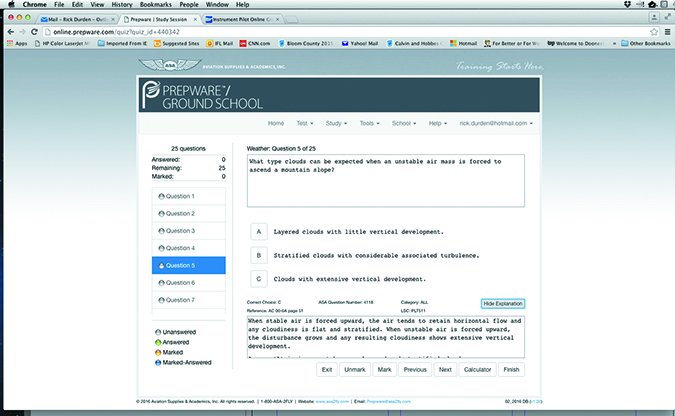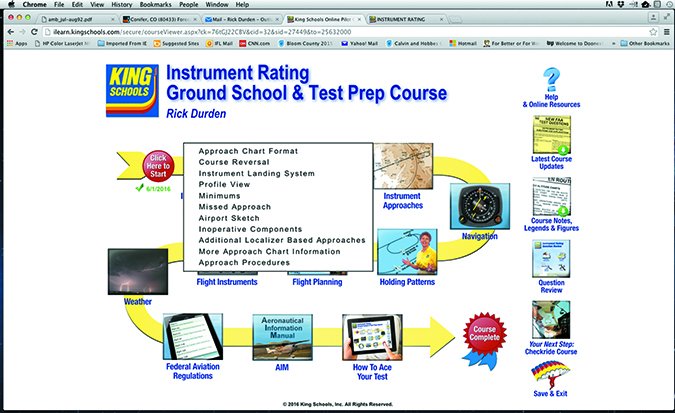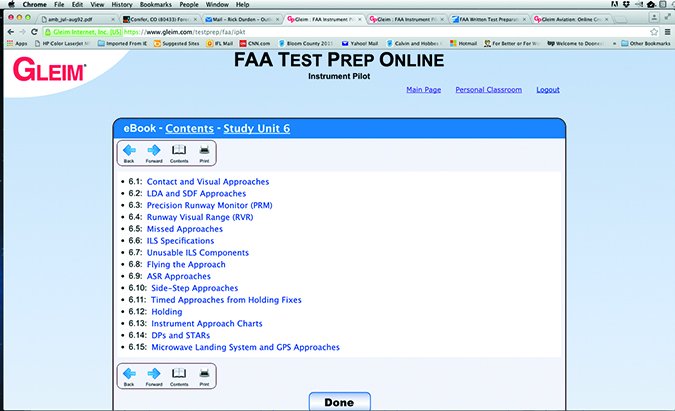We’ve long thought that the instrument rating knowledge exam is the most challenging written that most pilots take during their flying career. There’s no question about it, getting prepared for it involves some serious skull sweat.
We surveyed six of the more popular internet prep courses to see what was available, how they approached getting a student ready for the instrument written, what they cost and their convenience of use—notably whether they could be used on any internet-connected device or didn’t require connectivity while using. We came away feeling all were good—it’s a competitive market and the high quality of the products reflects it. From the perspective of creating a knowledgeable, all-around instrument pilot and getting ready for the written, we like King Schools and Sporty’s. For an inexpensive, power-cram, get-ready-for-the-written-and-nothing-else course, we lean toward Sheppard Air’s cold-blooded course.
The FAA stopped publishing the questions and answers to the writtens in 2007. It constantly makes subtle changes to the questions and answers, so keeping up with what’s on the instrument written requires ongoing work by the prep course developers—which all do. Nevertheless, that means that no company has a full database of the current FAA test questions and answers no matter what they claim.
We note that over the next year the FAA is going to be transitioning to a new framework for pilot certification, which it calls Airman Certification Standards (ACS). It will result in significant changes to all of the written exams, notably reflecting modern avionics on the instrument knowledge test. All of the test prep companies we surveyed told us that they have been keeping in touch with the FAA as it makes this change and are ready to go with updated courses once the instrument ACS are in place.

Sporty’s
Sporty’s written test prep is included within its $199.99 Instrument Rating Course, offered online, as an iPhone/iPad app and via DVD. We looked at the iPhone/iPad app and appreciated the flexibility it offers in being able to train anywhere there is an internet connection, and that it can be synced across multiple iOS devices—no Android.
The prep course includes 13 hours of videos that are, in our opinion, professionally produced and content-rich. The graphics were clear, the narration concise and while the length varied from just over three minutes to nearly 20 minutes, they broke the complex material down into segments that were reasonably bite-sized.
The videos are not limited to just the material that will be covered on the instrument written—something we applaud—so the course appeared to us to be designed to create a well-rounded instrument pilot who can operate within the system and deal with weather. At the end of most of the videos there is a review quiz in FAA-question format.
What Sporty’s calls its “Study Buddy” is an interactive written test preparation that is set up in three modes: Learning, Flashcard and Test. The Learning mode is broken down into categories of questions with a detailed explanation of each potential answer. Flashcard mode is just as it sounds. You read the question and give your answer—out loud or in your head—then “flip” the card by tapping “show answer” and see if you were correct. The Test mode provides a simulated exam, with a time limit and selection of questions designed to closely simulate the actual FAA exam.
Once you complete the videos and pass two simulated exams with a score of 80 percent or better, selecting “Written Test Endorsement” allows you to receive your endorsement to take the FAA written directly from the app.
We spoke to Sporty’s John Zimmerman about the course and he pointed out that one of the best sources his team has for keeping the course up to date is the flight school at Sporty’s. He said that while their students learn from them, they also learn from their students about what makes for the most effective learning materials.
ASA

Long known for its high-quality aviation textbooks and test prep books, ASA joined the online instrument written test prep world with its Virtual Test Prep. Priced at $199.95, it includes 10 hours of video presentations, a digital textbook and its successful Prepware material.
In a structured fashion, the student first reads the digital textbook chapters applicable to an overall section of the course. The student views the video applicable to the topic. The next step is to access the Prepware—FAA-style written test questions—presented first as a study session where the student gets feedback on each answer and then as a quiz that is timed and scored.
As we expected, we were impressed with the quality of ASA’s digital textbook. Content dense, we feel it is written to create a knowledgeable instrument pilot and not just pass the written exam. We also consider it a good reference manual for an instrument pilot to have in her or his library.
We think ASA is one step behind the competition when it comes to video. It was good but felt dated at times and not always focused.
The videos themselves are long—rather than break them up into convenient lengths, there is only one video per major topic. Plan on over an hour to get through each one. Even though you can access the course on any device with an internet connection, we were surprised that there was not a convenient way to stop a video, exit the program and then come back later and restart it at the same point. It’s necessary to scan through to find your stopping point.
Upon completion of the course and two practice tests with a score of at least 80 percent, ASA provides an endorsement to take the FAA written—or it will provide the evidence of completion and your scores to your CFI so he or she can sign your endorsement.
King

At $279, the online FAA Written Exam Course from King Schools is the most expensive of the courses we reviewed; nevertheless, we think it’s worth the price. The course is well-organized, content rich, user friendly and provides a number of handy study aids.
The course is organized into a recommend flow through the major subject areas. Clicking on a subject icon causes a pop-up menu showing lesson groups within the subject. Clicking on a lesson group reveals a menu of the lessons (usually three to six) within the group. Clicking on the lesson itself starts the video for that lesson. It sounds much more complex than it is and it provides a way to break complex subjects into digestible bits—with individual videos lasting on the order of 10 minutes.
As soon as a video is over, the first review question appears. Clicking on an answer generates immediate feedback. There is a running “report card” showing progress through the lessons as we’ll as the ongoing percentage score of correctly answered questions.
Once the student watches the video and answers all of the review questions correctly, the lesson title in the course menu turns green and the date of completion is shown. Even if a lesson has been completed, the student can return to it and view the video and go through the questions again.
There is an icon to access the entire library of review questions. In addition, there is an icon to access “hot sheets” issued regularly by King to update course content. King’s Barry Knuttila told us that King is regularly receiving information regarding test changes (King personnel are members of the FAA’s working group on its knowledge tests), so it updates the course once or twice a month.
Upon completion of all of the lessons, a score of at least 70 percent on the three practice written examinations and clicking on the endorsement icon, the course generates an endorsement for the student to take the FAA knowledge exam.
The course can be synced to any Apple device.
Dauntless
The approach taken by Dauntless over the last 15 years for its written test prep courses is different than the video or textbook method of most of its competitors. Using the technique of “learning by simulated testing,” Dauntless offers downloadable software for its instrument written test prep for $49.99. Available for PC, Mac, iPad, iPhone and Android platforms, the Dauntless course breaks down the test prep into 13 knowledge areas.
The student selects one of the knowledge areas and starts with the “test/study mode.” It introduces the student to the material by giving an FAA-style test question, the correct answer and an extensive explanation of the answer, often with high-quality graphics.
Once the student has gone through the knowledge areas in the test/study mode, the next step is to do it again in Dauntless’ “learning and practice” mode, which is a “gentle introduction and practice on the material.” The student answers test questions, gets immediate feedback and the system repeats questions the student got wrong.
The course progresses through more intense study modes as the student continues to take practice tests, until taking FAA-style tests in a format that simulates the real thing.
We consider the participatory learning approach an effective way of preparing for the instrument written; however, we are concerned that limiting oneself to simply preparing for the limited knowledge areas covered on the written test will leave holes in an instrument student’s education that may or may not be caught during dual instruction.
Gleim

We’ve always been impressed by Gleim‘s no-nonsense “just the facts, Ma’am” approach to training. Its $99.95 Instrument Pilot Test Prep Online course continues the tradition. It is a semi-structured course that first directs the student to read from an e-book and then take practice quizzes and finally, very realistic practice tests. There are no videos.
The e-book breaks the instrument prep material into 11 units with each unit being broken down into sections that rarely take more than 10 minutes to read carefully. There is no fluff in the material.
Though it’s not made clear in the introduction to the course, the e-book material may be read in any order the student desires; however, our review indicated that it is best consumed in the order presented as often material in one segment relies on knowledge obtained in an earlier section.
We liked that from the beginning of the e-book, the entire course is designed to make the student comfortable with the FAA computerized test formats and takes time to explain how they work.
From the e-book the student goes to Gleim’s question bank. In Study mode, the student can call up all or some of the questions for the particular topic just covered in the e-book. Clicking on an answer to a question provides instant feedback as to whether the answer is correct and why—an impressive detail. The course also keeps a running tabulation of questions missed and presents that data in a progress review section in a number of formats to allow the student to easily see his or her strong and weak areas.
There is not a lot of information on using the course in the introduction and we found ourselves hitting the wrong key and getting dumped from the website a couple of times.
We liked the clarity and presentation of the FAA figures that are used on the FAA test. It may be because Gleim effectively duplicates the presentation format of the FAA written, but we found them easier to read than many of its competitors’ presentations.
Gleim also provides an endorsement for the FAA written through the online course. To get the endorsement the student must have answered all of the required questions in the test prep correctly. If he or she requests an endorsement prematurely, the course presents a list of unanswered questions and directs the student to answer them.
Sheppard Air
The $40 Sheppard Air instrument rating test prep course is via downloadable software that is unabashedly designed to teach the student just what is necessary to pass the FAA written, including memorizing test questions and answers.
There is no claim that this course will help create a well-rounded instrument pilot. For example, the course instructions advise that if a mathematical calculation is going to take more than 30 seconds, it recommends not learning how to do the calculation, just “learn the concept” and memorize the correct answer.
The course includes a memory aid handout. Students are encouraged to print it out and keep it handy while studying to help memorize test answers.
The course is well-structured and organized, in our opinion. It calls for the student to go through the questions in a subject area with only the correct answer displayed. The student can click on an explanation box and get a very brief explanation of the correct answer. The student is then to go through the questions again with all the answers showing, learning to recognize the correct answer.
Sheppard Air claims that the answers appear in their software as “they appear in the actual test.” We have no way of verifying that claim, but it did rate a raised eyebrow as the FAA constantly makes subtle change to its test questions and answers.
After going through the study program as outlined, Sheppard Air recommends taking its practice exam. If the student gets a score of at least 90 percent, Sheppard Air issues a completion certificate and recommends that the student take the FAA exam immediately—as in 24 hours.
We do not recommend a prospective instrument pilot start his or her studies from scratch using the Sheppard Air written prep course. However, we think that the course can be an effective intensive cram-and-take-the-exam-tomorrow procedure for the pilot who has taken some sort of instrument ground school and has an understanding of the basics.
Conclusion
We like the quality of all the prep courses, especially of King and Sporty’s, with ASA and Gleim close behind. For pure, simple test prep without any pretext of creating a well-rounded private pilot, we lean toward the low price of Sheppard Air but like the explanations and graphics of Dauntless.


